1lumen selects and reviews products personally. We may earn affiliate commissions through our links, which help support our testing.
Thrunite TC20 V2 review

Thrunite TC20 V2 specifications
| Brand/model | Thrunite TC20 V2 |
|---|---|
| LED | CREE XHP70.2 6500K |
| Lumens | 4068 lm |
| Beam intensity | 22,400 cd |
| Battery config. | 1*26650 |
| Material | Aluminum |
| Modes | 5 |
| Blinkies | Strobe |
| Reflector | OP (orange peel) |
| Waterproof | IPX8 |
| Review date | June 2021 |
Introduction:
If you have been following the flashlight scene for a while, you probably know the name Thrunite. They are sort of an elder statesman in the flashlight business and have been making very nice lights since 2009. Yep, that’s way before the SRK craze, before Lumintop was cranking out umpteen FW-whatevers, and before anyone knew what a Convoy S2 was. If it makes light, Thrunite probably has you covered with fantastic options like the Archer 2A V3, Catapult V6, TN series throwers, TH series headlamps, W series EDC lights, and T series tactical lights. Basically, they make something for every application. Take the TC20. First introduced around 2017 as a general-purpose light, the TC20 was designed around a 26650 battery with a Cree XHP70.2 LED sporting micro USB charging. It was great, but it was getting a bit long in the tooth. Fast-forward 4 years and it has undergone a redesign and refresh for 2021. Thrunite was nice enough to send the new TC20 V2, and today we’ll be taking a look. The V2 promises some nice design and functional improvements over the predecessor. I like refreshes, and am a bit of an XHP70.2 fanboy, so let’s get to it.
Package quality.
The TC20 V2 arrived in a pretty simple recycled cardboard box with the Thrunite logo and some specs on it and not much else. It’s remarkably similar to the box the Archer 2A comes in, even down to the flexible rubber band holding the box halves together (just bigger). Now I know better than to judge a book (or box) by its cover, and I must say Thrunite’s simpleton boxes aren’t a bad thing because they look nice and I dig the utilitarian look. The boxtop lifts off to reveal the TC20 V2 inside a LPE bag nestled in microcell foam padding to keep everything safe. There’s a ton of accessories hiding under the light, and here’s what you get:
- Thrunite TC20 V2
- 2 spare o-rings
- 2 spare USB charging port covers
- Spare switch seal
- Keyring
- Thrunite-branded 5000 mAh flat top protected 26650 battery (loaded in the light)
- Lanyard
- User manual
- Battery quick start card
- USB type C charging cable
- Holster
I don’t know how they crammed that in there, but this is a fantastic assortment of accessories, to the degree that if something’s missing then you probably don’t need it. You get everything needed to get going, which is nice since I hate buying things that should be bundled, so thanks Thrunite! The accessories look to be good quality also, especially the lanyard, and that’s nice because accessories are usually where companies cheap out and save money.

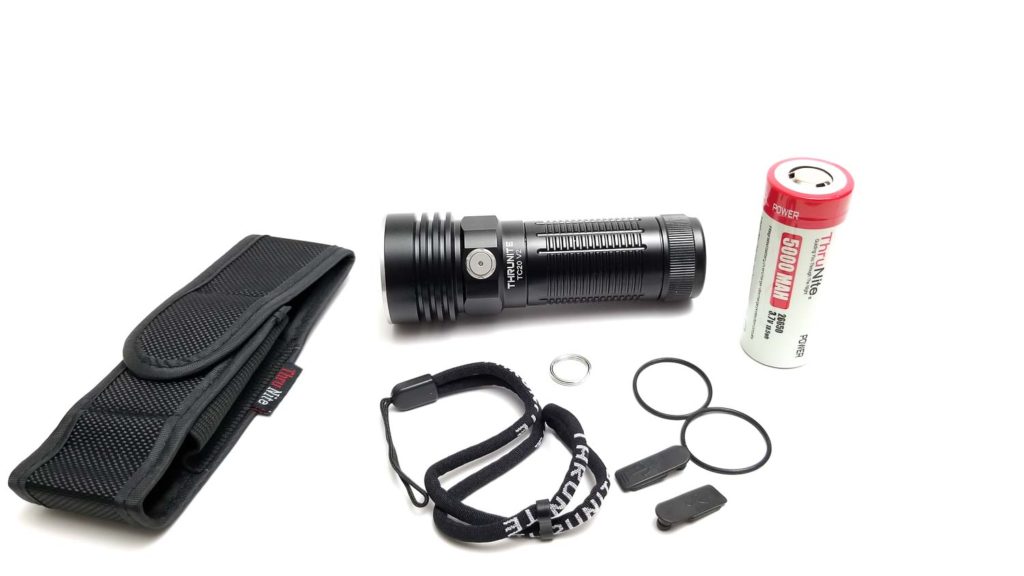
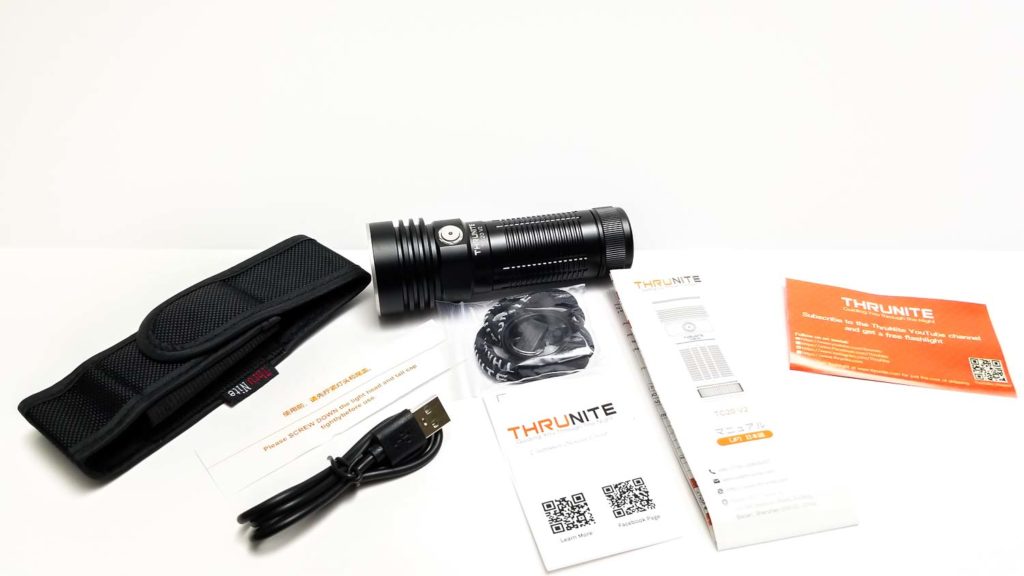
Flashlight in use
The TC20 V2 is dimensionally the same size as the TC20. It’s a 26650-size body, so naturally it handles nicely because it fills out your hands. Although it’s not as nice as a slimmer and longer 27100-size light to handle, this is a compromise of sorts and if you’re used to an Astrolux EA01 or MF01 MIni, then you will be right at home with the TC20 V2. The reeding on the battery tube and ribbing on the tailcap adds traction, and it has good heft. This is good because it feels like there’s a good amount of thermal mass in the head, which also has deep heat sink fins for added heat dissipation. There’s no anti-roll cuts, so it will roll away on inclined surfaces, but adding the lanyard helps with that. One thing I really appreciate is the added split ring for the lanyard hole. It makes attaching the lanyard tons easier, and trust me, an eternal struggle awaits you if you try to thread the lanyard through the small lanyard hole without the split ring (yes, I tried). There’s no pocket clip, but Thrunite did include a nice holster. The light fits snugly in the holster for bezel down carry, and is easy to extract without hanging up.
The front-mounted e-switch is retained from the first version. It’s a metal button with an indicator light in the middle for on-state and battery condition. The travel is acceptably short, and the action is stiff with a solid snappy click and decent feedback. No complaints with the switch. The stiffness will help with accidental activation which is important since there’s no electronic lockout. The switch is easy to find by feel and manipulate, but the indicator light only illuminates when turned on (it’s a nice blue LED) or charging (red). There’s a flat tailcap so tail standing is not an issue.
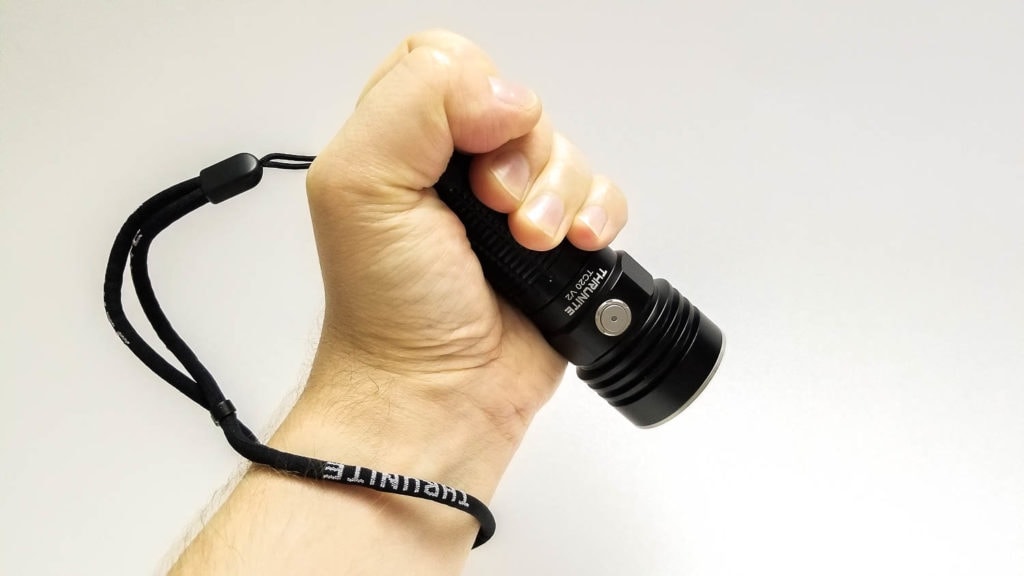
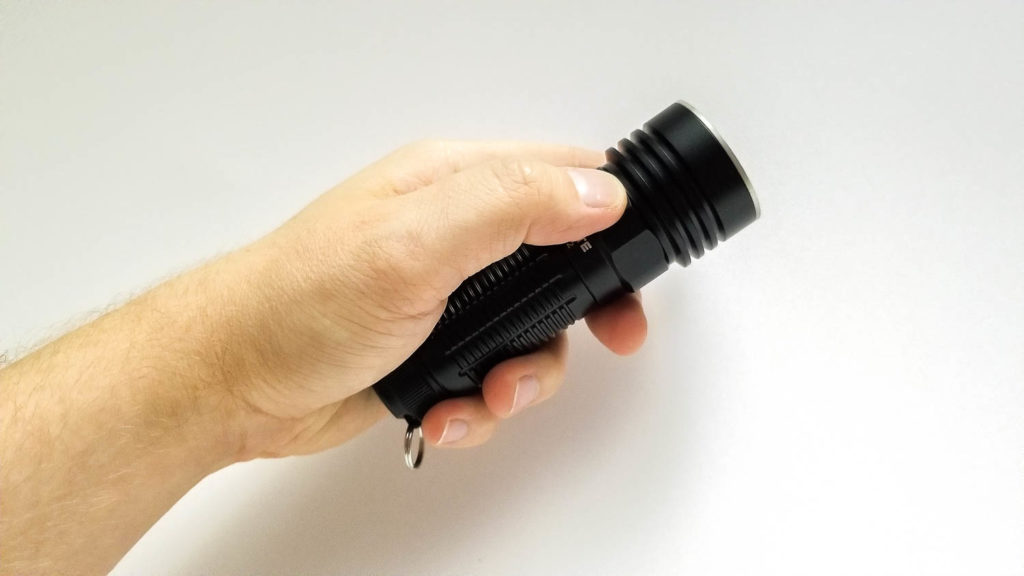
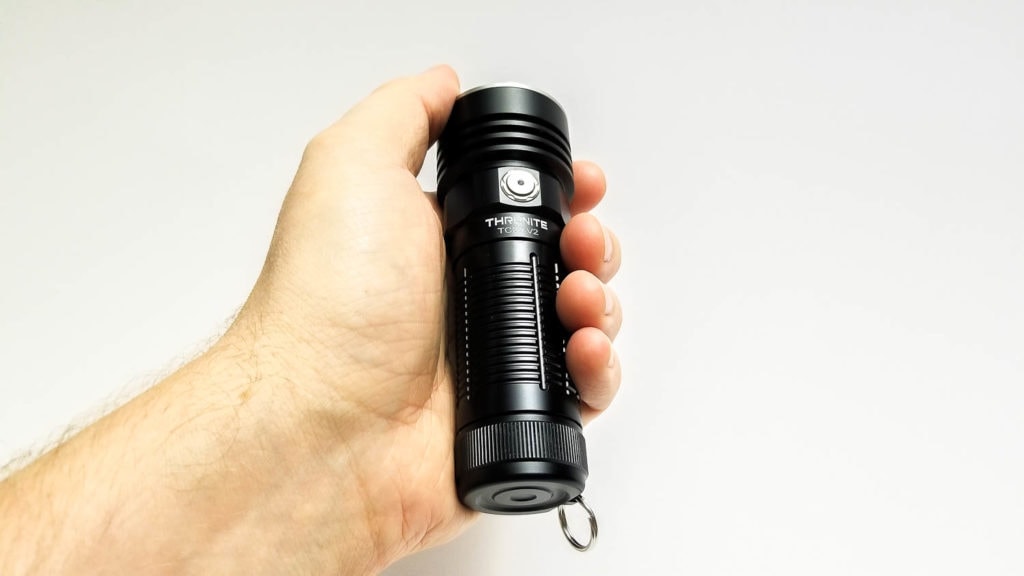
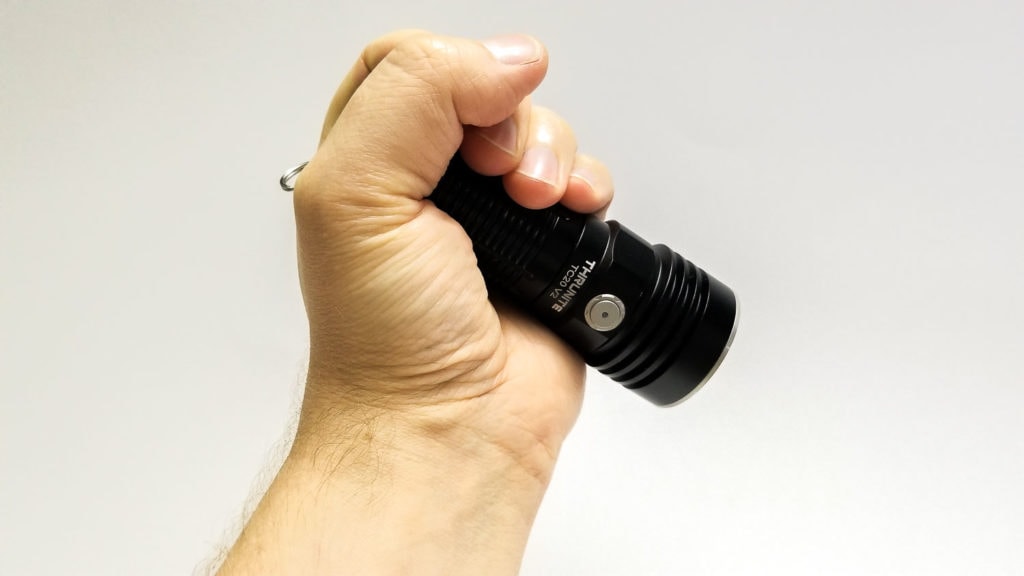
Build Quality, and Warranty
This is the first Thrunite light I’ve reviewed, and for the asking price, the quality, fit, and finish are on point. There weren’t any defects in the machining, no burrs or tool marks, and all the parts fit together evenly with no gaps. All the edges are nicely beveled, with the exception of the edge where the bezel meets the head there was a bit of an abrupt edge. Nothing too major, but definitely noticeable. The silk screen text was sharp and well done. It also passes the Maracas test; no major rattles when shaken.
The light is made from durable 6061-T6 aluminum alloy with deep black type III HA anodizing. The finish is more semi-gloss than matte, and while not my favorite, seems durable and should take some abuse. The original TC20 had traditional diamond pattern knurling on the battery tube and tailcap, but the V2 has reeding on the tube and ribs machined into it for grip. It’s a nice texture for gripping and allows for good control even with wet or slippery hands.
The light breaks down into three parts: head, battery tube, and tailcap. I tried unscrewing the bezel, but it’s glued or Loctited. The tailcap has a dual spring arrangement pressed into the tailcap (no PCB) for maximum current flow, which is nice to see. The springs are gold plated, and the outer spring is pretty short, but substantial. The driver side has a brass button for the battery positive contact.
The rear threads are good-sized and very precisely rectangular cut. Oddly, the rear threads are not anodized, but the front threads are, save for a 2.5 mm straight section that’s bare and makes contact with the driver’s ground ring. This makes locking out the light possible by unscrewing the head 1/6th turn, not the tailcap. Thrunite even includes a note in the box instructing you to tighten the head before use as there was no isolator between the negative end of the battery. Interesting. The threads weren’t the smoothest, and although lightly lubricated, were crying for some SuperLube. Once lubed, they were super smmmoooth. Same with the cover to the USB charge port. It was a little tough to fully seat, but a very light coat of SuperLube helped. Thrunite gives the light a generic IPX8 rating, so it should be good for temporary immersion up to 2 meters.
Thrunite is a mainstream brand and stands behind their products, so you get a commensurately robust warranty: 30-days no hassle/haggle free return and refund, 2-year free replacement for factory or manufacturing defects, and a limited lifetime warranty with covered labor for repairs (customer covers parts and shipping). As a bonus, Thrunite extends the free replacement an extra year for registering your product. Nice!
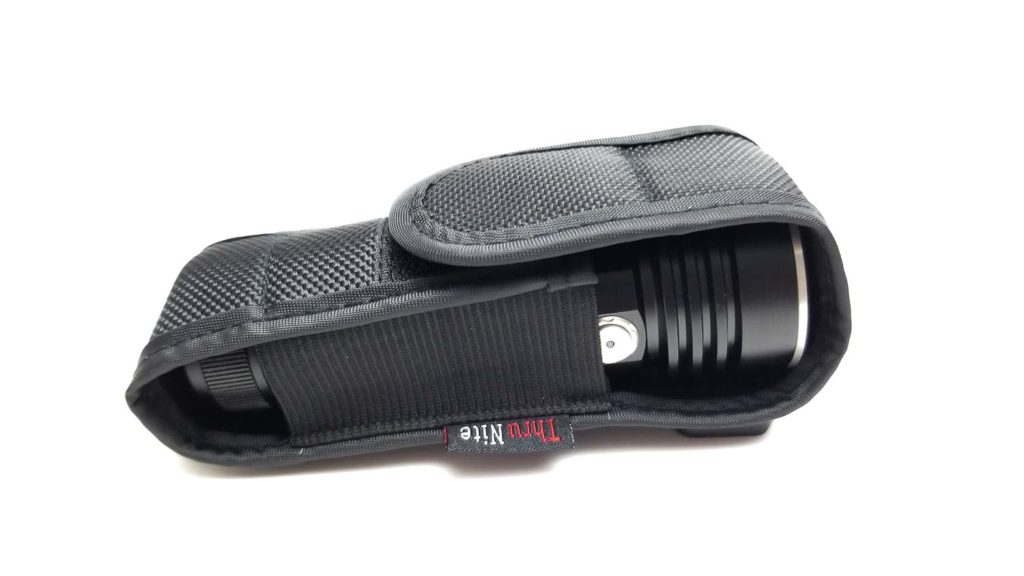
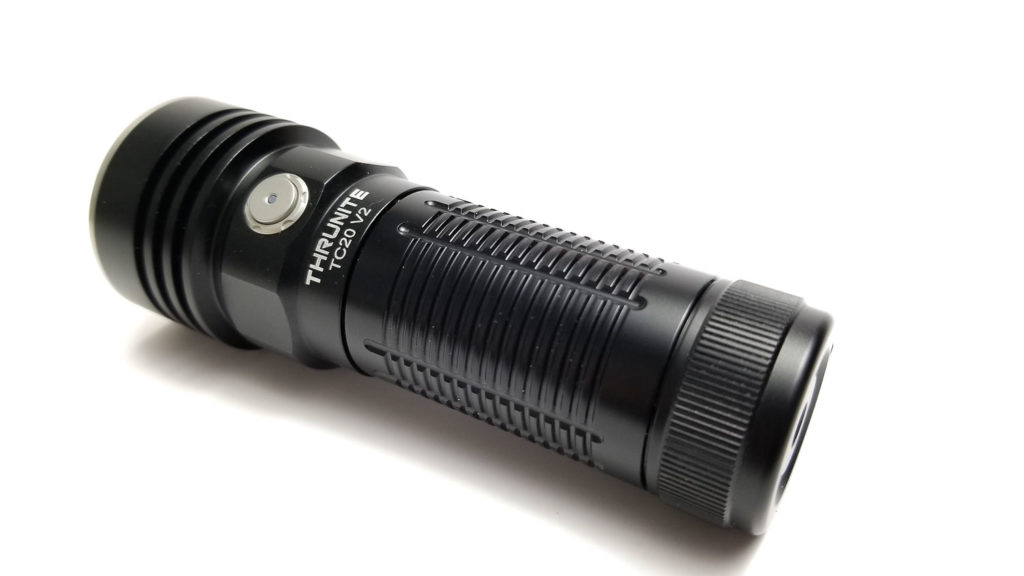
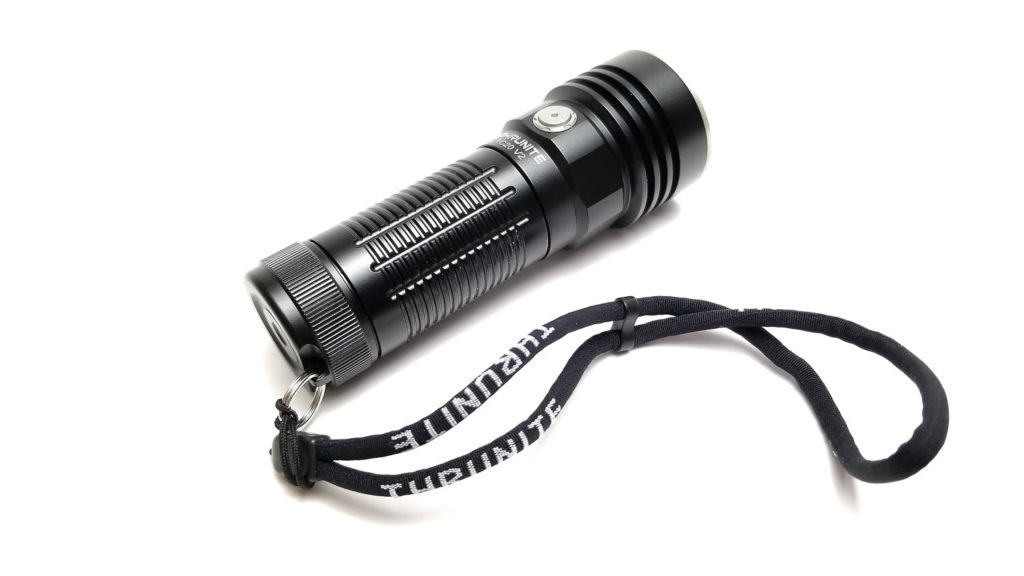
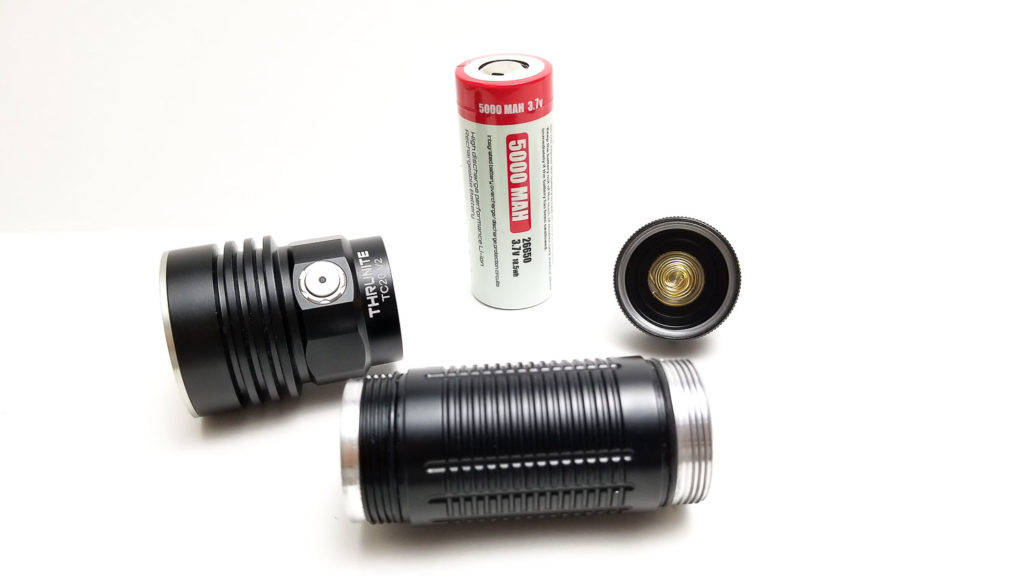
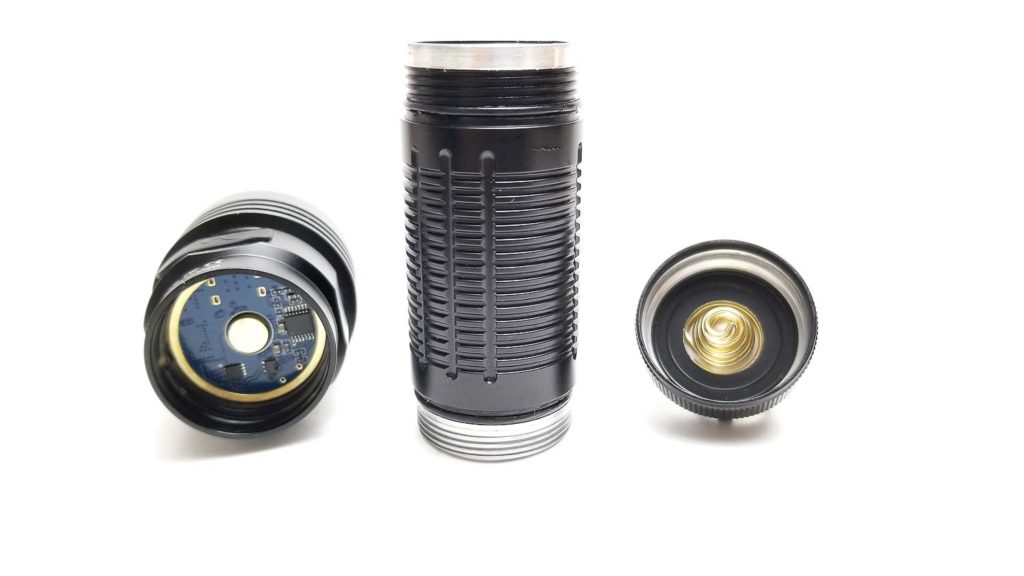
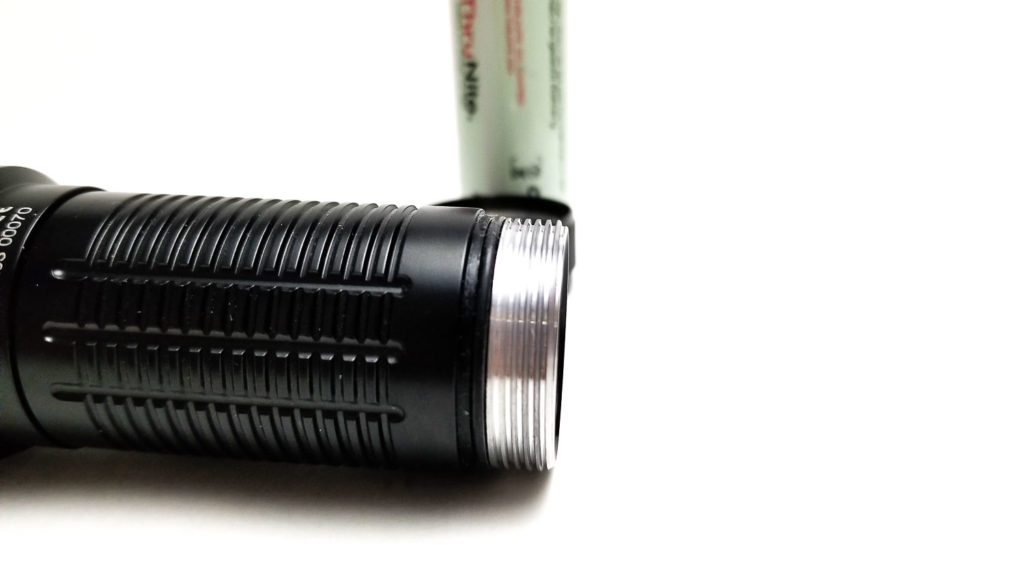
LED, Lens, Bezel, and Reflector
Like the original TC20, the V2 carries forward the trusty Cree XHP70 gen 2 emitter. To be honest, there aren’t many emitters on the market as versatile as this one. The XHP70.2 is a 7×7 mm quad-die LED running on 6 or 12 volts Thrunite gives you a choice of two tints; neutral white or cool white. Mine came in cool white, which although not my preferred tint, is better for output. I think this emitter is perfectly suited to a single-cell compact light because when paired with a good quality boost driver, it’s efficient and capable of high output at modest drive currents so it runs cool.
The LED is paired with an aluminum orange peel (OP) textured reflector topped with a toughened mineral glass lens with AR coating for maximum light transmission. The bezel is matte finish and looks like stainless steel. It’s not crenulated, so you won’t know if it’s turned on if you set it bezel down. I will say it looks slick with the black finish, matte switch, and bezel. Thrunite could have gone with a shiny bezel, but the matte finish looks much better in my opinion.
Thrunite did a good job matching the LED to the reflector. The beam is expectedly floody, but has a good amount of throw. The large hotspot is diffused with a smooth transition from spot to spill thanks to the OP reflector. The XHP70.2 throws out a wall of cool white light, and I was pleasantly surprised with the uniformity of the beam. However, the price of admission to the XHP party is paid with corona and tint shift. The OP reflector helps, but it’s still there and noticeable even when not white wall hunting.
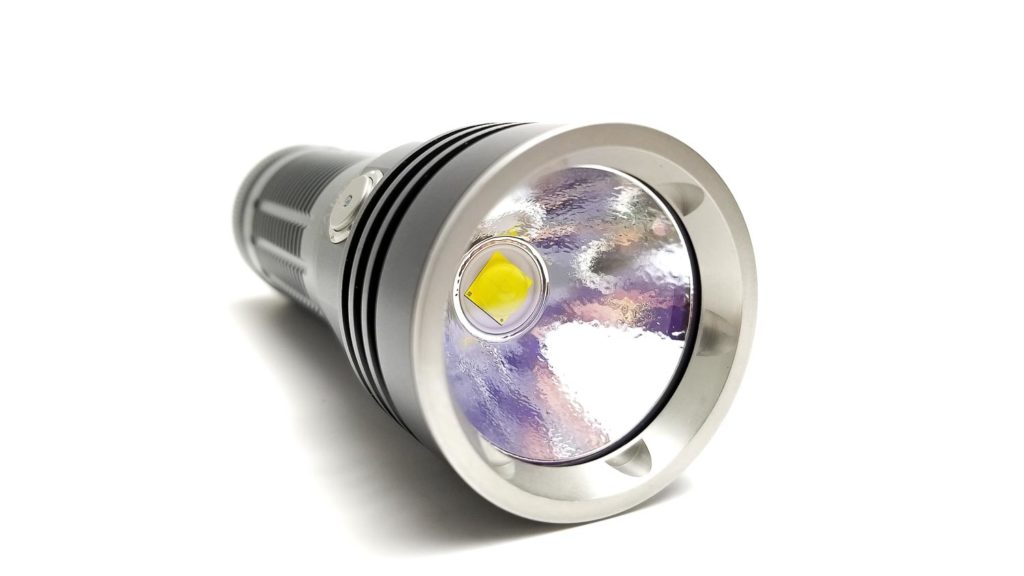
Dimensions and size comparison
- Length: 11.9 cm / 6.85 inches
- Head diameter: 4.2 cm / 1.65 inches
- Body diameter: 3.35 cm / 1.31 inches
Weight:
- With 5000 mAh 26650 battery: 242.6 grams / 8.55 oz.
- Without battery:143.2 grams / 5.0 oz.
Flashlight comparison
Left to right group 1: Thrunite TC20 V2, Astrolux EA01, Astrolux EC03, Thorfire C8.
Group 2 left to right: Thrunite TC20 V2, Lumintop FWAA.
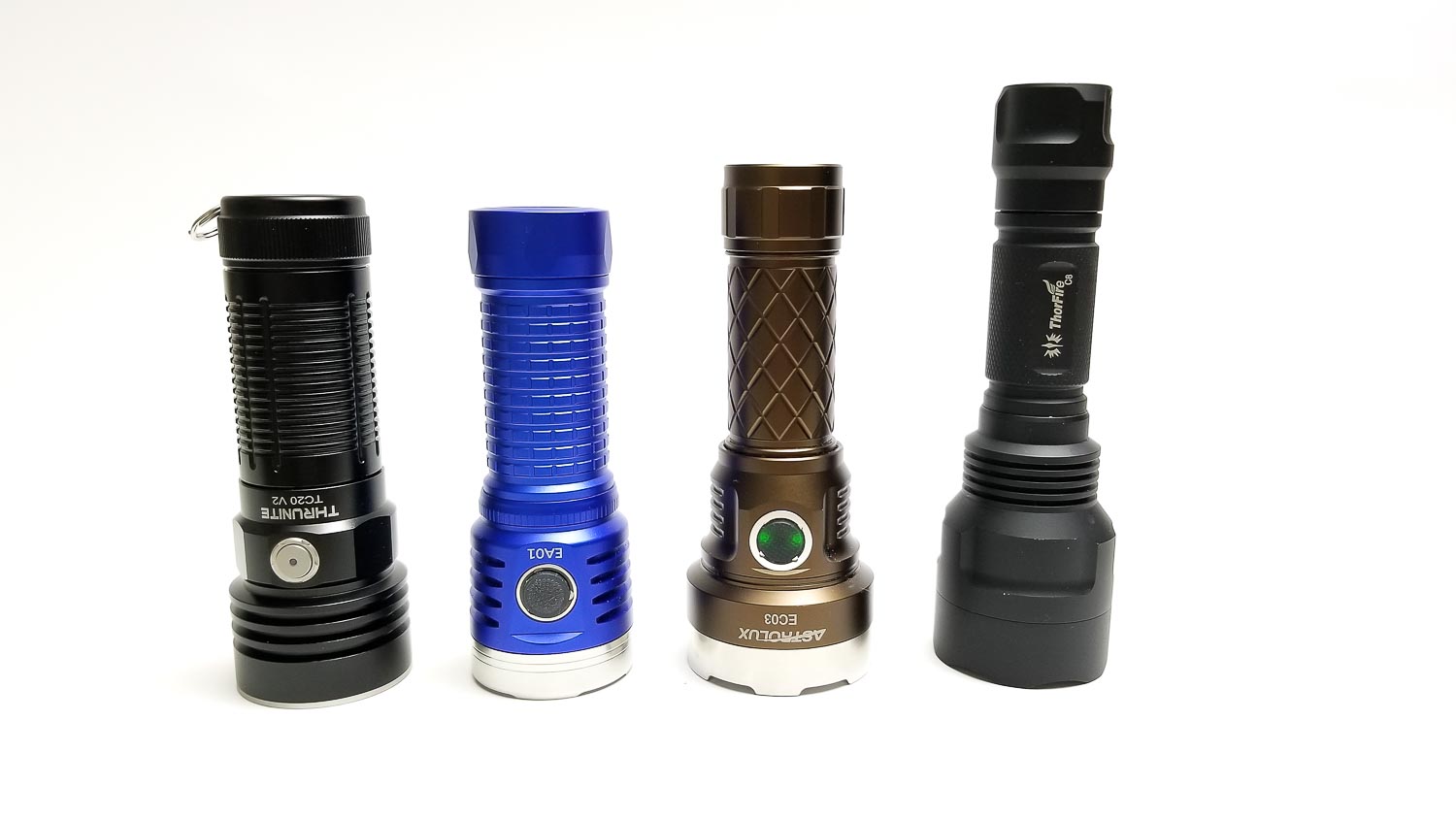

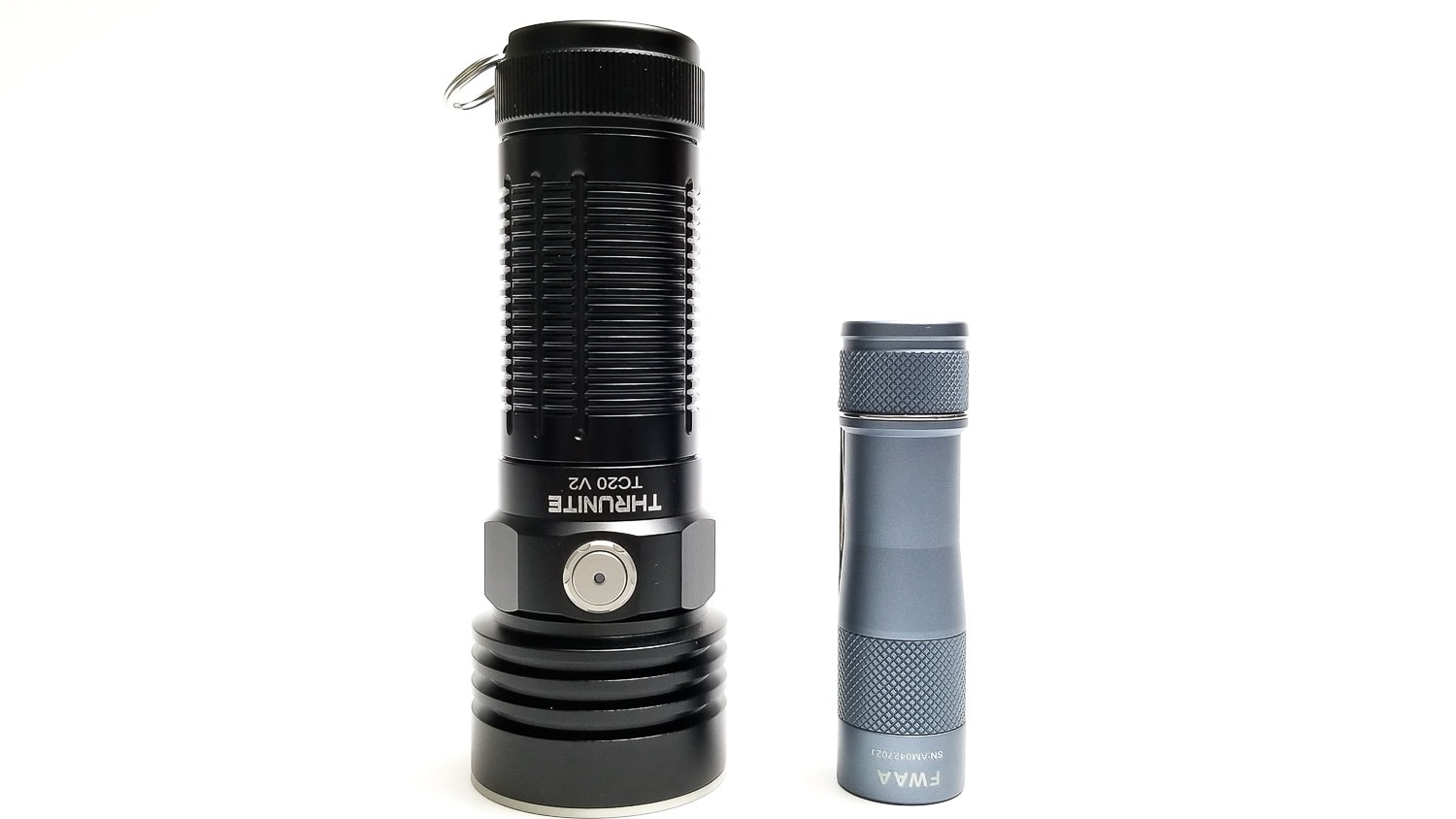
Driver & User Interface:
The TC20 V2 employs a constant-current boost driver to step the 4.2 volts from the battery to the 6 volts for the XHP70.2. It’s a great combination for output and efficiency. You can get high output at modest drive currents for sustained output without generating tons of heat or voltage sag on the battery.
The UI is delightfully simple and well thought out. It’s perfect for a general purpose light like this.
Modes: Firefly, low, medium, high, and turbo. There’s a semi-hidden strobe mode also.
From OFF:
- Press and hold: Firefly mode
- Single click: Turns on in last mode
- Double click: Turbo
- Double clicking again in turbo switches to strobe
From ON:
- Press and hold: Switches to next mode L-M-H-L
- Single click: Turns off
- Double click: Turbo
- Double clicking again in turbo switches to strobe
Mode memory:
- Yes, last mode memory
Low voltage warning:
- Yes, the switch indicator will flash red when the battery is at 3-2.8 volts. The light will turn off when the cell voltage goes below 2.8 volts. From the manual: 1-10% flashing red indicator, 11-20% solid red, 21-100% solid blue.
Strobe/blinkies
- Single strobe at about 3 Hz
Lock-out mode:
- None. Unscrew the head ⅛ turn to manually lock out.
PWM
- None.
Additional info: There’s just something about a simple UI that’s refreshing to me. Don’t get me wrong, Anduril’s great, but a flashlight should be easy to use for non-flashaholics, and amongst the complicated UI’s we’re getting these days, it’s nice to see Thrunite implementing a very useful UI in the TC20 V2. The single strobe is pretty hidden so you won’t be accidentally activating it. The mode spacing combined with a true sub-lumen mode is icing on the cake. The mode cycling speed is a little slow for my taste (about a 1 second pause between), but this really is a light anyone can pick up and use without fretting over turning it on or changing modes. The TC20 V2 features Thrunite’s version of temperature regulation, and it really works great, much like the sensor in Anduril, except this one’s fixed at about 50 C. This means the light shouldn’t get too hot to handle.
Batteries & Charging
The V2 uses the same 26650-size battery as the first version. Like the original, the TC20 V2 comes with a Thrunite-branded high discharge 5000 mAh protected flat top 26650. I measured it at 69.3 mm long. If you want a spare, Trunite also sells this battery separately. It’s nice to see that this isn’t a proprietary cell, and any flat top or button top 26650 will work in the TC20 V2. I tried a Wurkkos-branded button top 26650 and it fit fine. The protection circuit is properly beefy. I tested this battery in my FT02S and it easily pulled 25 amps for several seconds without tripping the protection circuit.
The V2 retains the onboard charging, but instead of micro USB, the V2 now features USB type C charging. This is a major upgrade from the dated micro USB and Thrunite specs the charge current at 2 amps. On my 2.1 amp wall adapter, I got 1.92 amps with a nearly-drained battery. The onboard charging should recharge a flat battery in around 2.5 hours, which is pretty quick! Yes, you can remove the head and keep it plugged into a charger and use it, albeit at significantly reduced output.
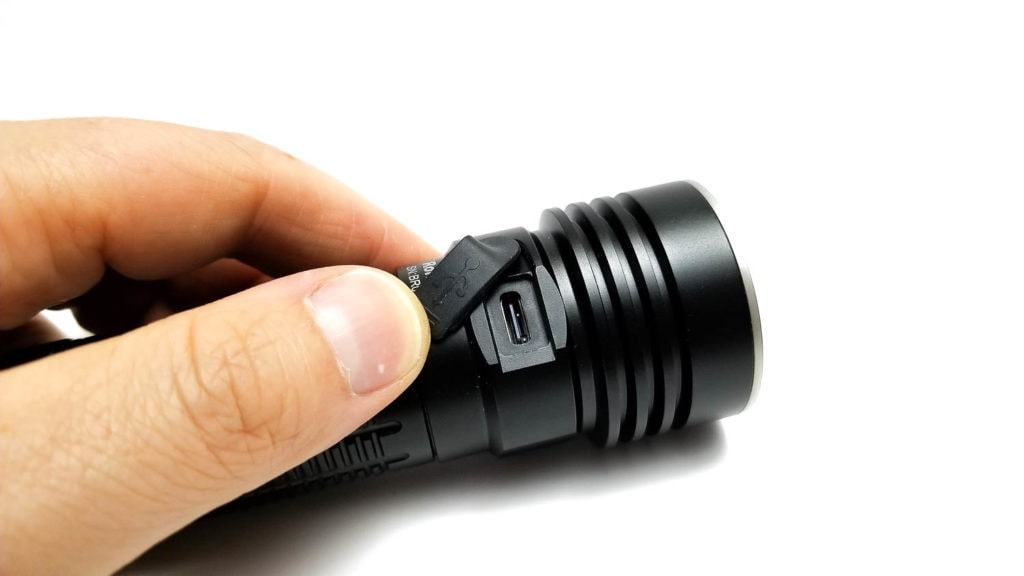
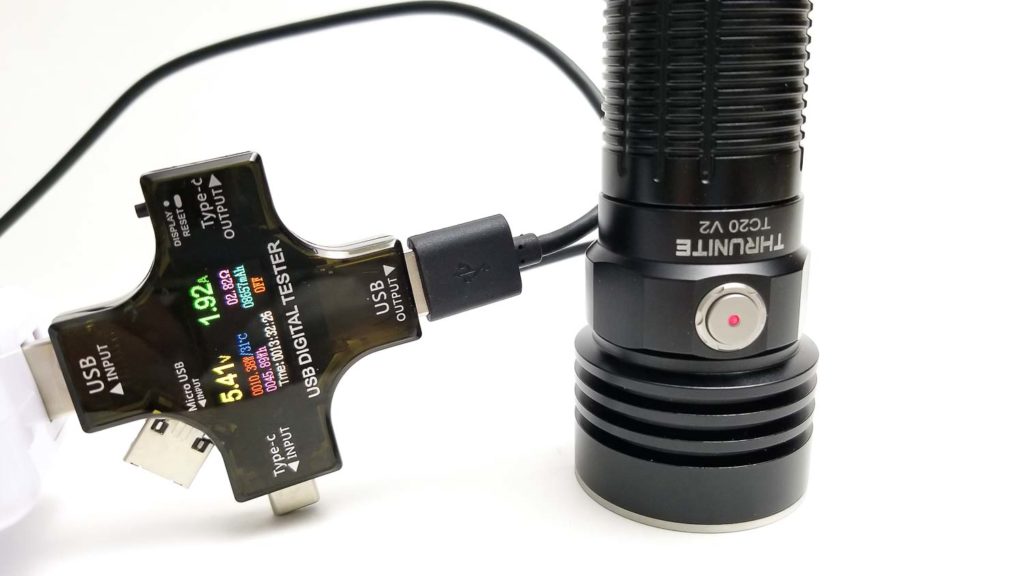
Performance
I’m pretty amazed at the output figures we’re getting from small lights these days, and I’m expecting great performance from the TC20 V2. Thrunite promises a modest performance upgrade from the original, so we will see how it does.
Amp measurement
It’s hard to trust current figures from a boost driver since it’s not the actual output current to the LED. What you see here is the input current from the battery, but here we go:
- Firefly: 2 mA
- Low: 80 mA
- Medium:500 mA
- High: 3.12 A (3.85 A at turn on)
- Turbo: 10.30 A (10.50 A at turn on)
Parasitic drain:
- 0.16 mA.
Runtime graph
I conducted the runtime test using the 30-centimeter integrating sphere with the Digi-Sense 20250-00 data logging lux meter. I used the fully charged Thrunite 26650 battery and tested all modes (except strobe, low and firefly since they run for days and days…ain’t nobody got time for that).
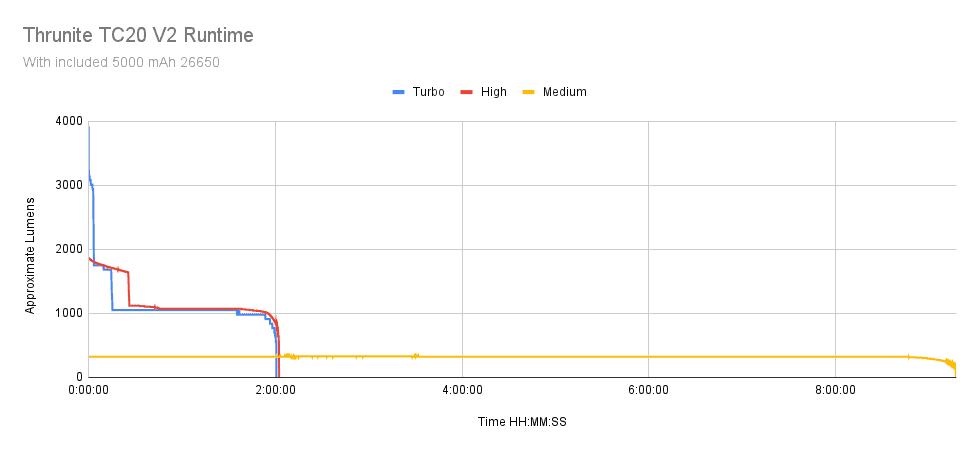
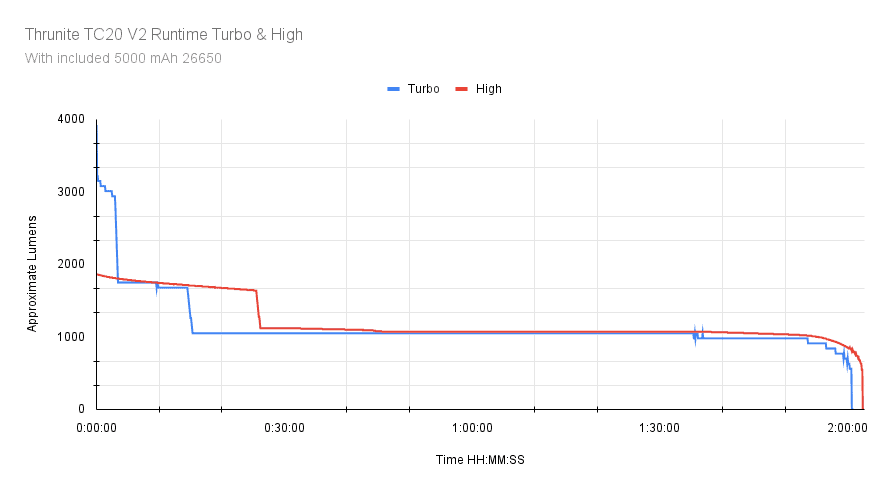
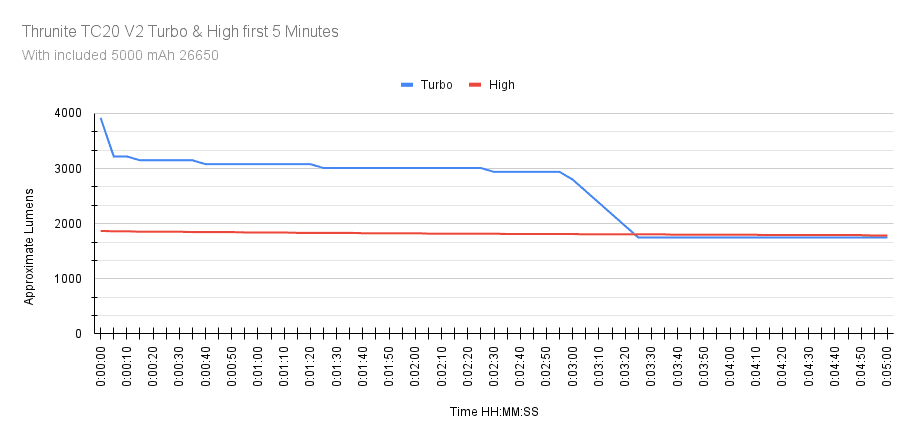
Turbo mode started at a little under 4000 lumens, which is pretty good for a small light. The stepdown happened within 5 seconds to 3220 lumens, with gradual decreases over the next 3 minutes. The light holds 3000 lumens or better for over 2 minutes. Not bad. I didn’t notice any significant heating until about the 30 second mark, around 25 C over ambient. The output dropped to under 2000 lumens by the 3 minute 25 second mark, and held that for 6 minutes, followed by slight stepdowns over the next 15 minutes, until settling at 1050 lumens for the next 1 hour 15 minutes. The last 24 minutes of the runtime consisted of gradual stepdowns, with a hard shutdown at the 2 hour mark. Thrunite says 220 seconds + 90 minutes for the runtime (that’s 1 hour 33 minutes 6 seconds). If you aren’t paying attention to the LVP indicator light on the switch, you’ll be in for a surprise because the output was still over 500 lumens when the light quit. Temperatures got up to 56 C at the head and a reasonable 50 C at the battery tube.
High started off at 1869 lumens, which lasted for several seconds before slowly tapering off. The output is still holding over 1850 lumens for the first 30 seconds, and after 5 minutes the temperature is 52 C and the output is holding steady at 1785 lumens. That’s pretty impressive, but more impressive is the sustainability. The light holds 1700 lumens for almost 17 minutes, and only steps to under 1000 lumens at the 1 hour 55 minute mark. Here, the output takes a steep dive and tapers off as the LVP indicator starts flashing red. The light runs for another 7 minutes before the driver pulls the plug and the light shuts off at 2 hours and 2 minutes. Thrunite specs 2 hours 22 minutes for the runtime, so close enough.
Medium started at 322 lumens and in true boost driver fashion, held that output forever. Well, it seemed like forever, since the output didn’t drop below 300 lumens until 8 hours and 58 minutes into the test. For the next 19 minutes, the output steadily dropped as the battery voltage drained until the 9 hour 17 minute mark when the light shut down with the same abrupt cutoff as high and turbo. The only indication you get that shutdown is imminent is the flashing indicator light. I didn’t notice any remarkable heating in the light during the run, maybe 5 degrees above ambient. Thrunite specs 9 hours for the runtime, so again pretty bang on.
Some observations: Since this is a boost driver, it only pulls as much current as it needs for the duration of the runtime tests to keep a steady voltage to the LED. With a stout, high capacity battery, that means long runtimes and consistent output. It seems the protection circuit on the battery is set to 3 volts since the battery was around 3 volts after each test. Overall, the TC20 V2 has a nicely tuned boost driver and works really well with the LED. The runtimes are close to the factory specified, which is nice. I didn’t observe any wild fluctuations in output or see-saw behavior from erratic temperature regulation either. This flashlight will guarantee long runtimes and consistent output, all good things and a testament to careful engineering in my book. However, I didn’t like the abrupt cutoff with no visual warning (other than the indicator light), nor the fact the light was deader than Jimmy Hoffa and non-functional after the tests.
Lumen measurements (for each mode)
For the lumen tests, I used my home made 30 cm integrating sphere calibrated with a light of known output using the Digi-Sense 20250-00 data logging lux meter. I used the included fully charged 5000 mAh battery. Readings were taken at 30 seconds. I captured the turn on reading for turbo.
| Mode | Measured Lumens | Specified |
|---|---|---|
| Firefly | N/A | 0.3 |
| Low | 43 | 35 |
| Medium | 329 | 320 |
| High | 1841lm (1869 at start) | 1853 |
| Turbo | 3780lm (3920 at start) | 4068 |
Firefly mode was too low for the Digi-Sense to measure, which tells me it probably is sub lumen, or at least close. Overall, this is very good performance from a compact light! Very versatile mode spacing with a very wide range of brightness at your disposal. I’m a little under Thrunite’s turbo spec, but the other readings are on point and more importantly, consistent.
Throw numbers:
Throw was measured at 5 meters indoors using the Uni-t UT383S lux meter. I used the included Thrunite 5000 mAh battery for all tests. Readings were recorded at 30 seconds.
| Mode | Measured Throw | Advertised Throw |
|---|---|---|
| Firefly | N/A | ? |
| Low | 275 cd, 33.16 meters | ? |
| Medium | 2275 cd, 95.39 meters | ? |
| High | 12,850 cd, 226.71 meters | ? |
| Turbo | 27,375 cd, 330.90 meters | 22,400 cd, 299 meters |
Again, Firefly was too low for the Uni-t to measure. Thrunite only listed a single ‘max’ throw figure in the literature, probably turbo. I was not expecting this much throw from a reflector smaller than a C8. This is more fantastic performance from the TC20 V2 and goes to show that even after all these years, the XHP70.2 still has the right stuff.
Beamshots
I compared the TC20 V2 to the Astrolux EA01 and a Thorfire C8 with a 6000K XHP50.2 3 volt, at around 3200 lumens.
- Outdoor shots: The fence is about 95 meters away. We can see the TC20 V2 is the flood winner, but still has decent throw. EA01 is the obvious throw winner, with the C8 not far behind. I think for general purpose use, the TC20 V2 is still the best.
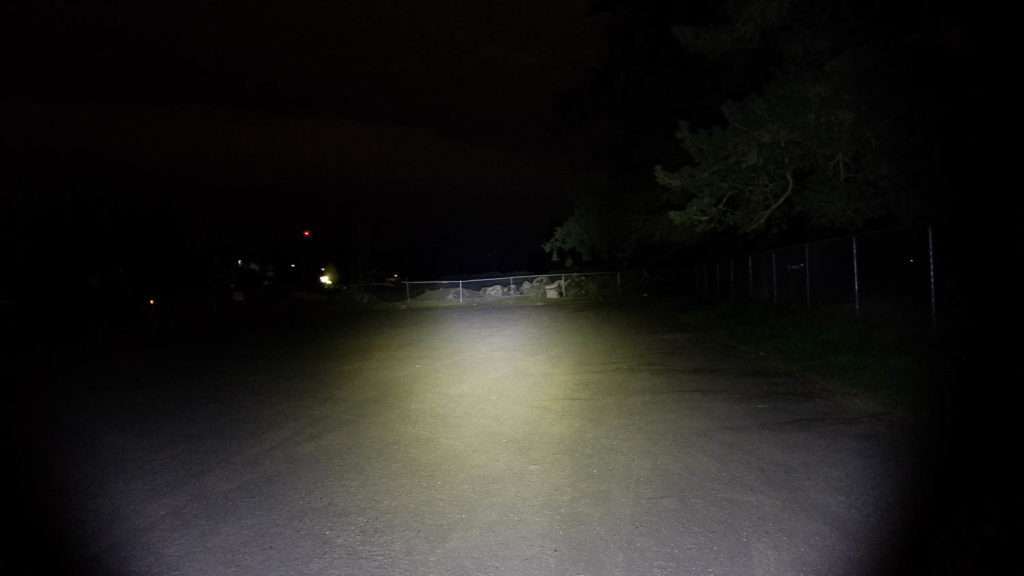
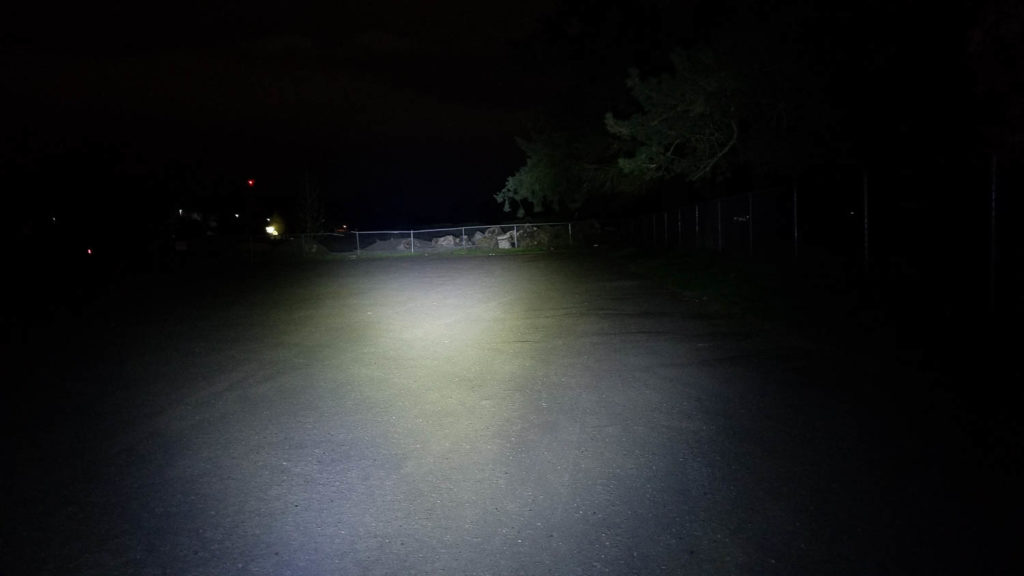

Disclaimer: This flashlight was sent to me for review at no cost by Thrunite. I have not been paid to review, nor have I been holding back on problems or defects.
Final Verdict
Pros
- Excellent fit, finish and build quality
- Simple and intuitive UI
- Properly fast USB type C charging
- Consistent output
- Doesn’t get too hot
- Versatile beam with great throw
- Included battery is excellent
Cons
- Abrupt shut off for LVP
Explanation on star ratings:
1: Avoid: my phone flashlight would be a better choice – 2: Poor: significant defect or issues, much better options available at the same price – 3: Average: some defects or issues – 4: Good: recommended (minor issues) – 5: Great: highly recommended

5 stars: ★★★★★
Thrunite has been making flashlights for a long time, and it’s reflected in their products. The point of a second edition or version of a product is to make it better than the original, and I think Thrunite has done a fantastic job here. The original TC20 was a great light, but the V2 does one better. The improved driver and onboard charging upgrade, excellent battery, and optimized reflector make for some nice increases in performance and functionality.
I’m glad Thrunite didn’t fix what wasn’t broken, and their attention to detail is very nice. The TC20 V2 doesn’t get too hot during extended high output runs, the beam is super versatile, it sustains high output for a long time, and the driver is nicely regulated. It’s also worth mentioning the included battery is fantastic. I can’t think of anything major to nitpick on the TC20 V2 without going primadonna on it. However, if I could change one thing, I’d put in some kind of visual LVP notification (a blink, blip, something) to supplement the indicator light because the abrupt shut down at the end of the runtime tests were annoying.
Overall, this is about as good as it gets for a general-purpose tube light. Yah, it’s a bit chubby, and 21700 lights are the future, but seriously, for the price and performance, the TC20 V2 is that good. Bob’s your uncle and 5 stars all the way.
Thrunite TC20 V2 For Sale
Amazon.com United States
Amazon.co.uk United Kingdom
1lumen selects and reviews products personally. We may earn affiliate commissions through our links, which help support our testing.